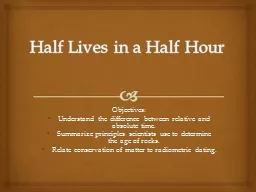

Objectives Understand the difference between relative and absolute time Summarize principles scientists use to determine the age of rocks Relate conservation of matter to radiometric dating How do you think scientists tell the age of fossils ID: 646798
Download Presentation The PPT/PDF document "Half Lives in a Half Hour" is the property of its rightful owner. Permission is granted to download and print the materials on this web site for personal, non-commercial use only, and to display it on your personal computer provided you do not modify the materials and that you retain all copyright notices contained in the materials. By downloading content from our website, you accept the terms of this agreement.
Slide1
Half Lives in a Half Hour
Objectives:
Understand the difference between relative and absolute time.
Summarize principles scientists use to determine the age of rocks.
Relate conservation of matter to radiometric dating.Slide2
How do you think scientists tell the age of fossils?Slide3
Radiometric dating is a term used to describe how scientists are able to determine the age of a rock.
Radioactive
material can be found in all rocks. This material decays over time which allows scientists to determine the absolute age of a rock.
Rate of decay is based upon time.
Determining Age
Radiometric DatingSlide4
First let’s review the parts of the atom,
Protons
are
positively charged particles that are found in the center, or nucleus, of the atom. All atoms of the same element have the same number of protons.Electrons are negatively charged particles that are located around the nucleus, or the center of an atom, in a cloudlike formation
Neutrons
are neutral particles, they have no charge. They are also found in the nucleus of the atom. Most atoms of the same element have the same number of neutrons. The few that have a different number of neutrons are called isotopes. Isotopes are always changing. They give off energy; because of this we say they are radioactive. Eventually they will give off so much energy that they will change into a different type of atom. We call this radioactive decay. Scientists have studied isotopes and know about how long it takes them to decay into new elements.
AtomsSlide5
An element has a fixed number of protons and neutrons. All
isotopes
of that element have the same number of protons but different numbers of neutrons
.Parent isotope- is first present. This is radioactive and the parent element will naturally and spontaneously decay ( release energy).Daughter isotope- The parent element is no longer the same and is converted to a daughter element. Just like mother and daughter are two different
peope
.IsotopesSlide6
Radiometric dating is dependent upon an element’s half-life. Half-life
is the amount of time it takes for half of the parent isotope to decay into the daughter isotope
.
Carbon-14 has a half-life of 5, 730 years. ( Carbon 14 has six protons and 8 neutrons) When a neutron collides a nitrogen-14 atom becomes a Carbon-14 atom and a hydrogen atom)
Radiometric DatingSlide7
Time to take a closer look. Please take a sheet of paper, tear it into 20 pieces, or any item that you can easily attain and count out 20 of that item.
~All Hands On Deck~Slide8
Each toss will represent a half-life for your practice sample.( This is your parent isotope)How much of the parent isotope decays into the daughter isotope after one half-life ( toss)?
How much of the parent isotope will decay into the daughter isotope after three half-lives?
~Hands On~Slide9
Starting with 100 grams of carbon-14 in a substance, how long would it take until only 50 grams of the parent isotope remained?
Now, how long would it take until only 25 grams of the carbon-14 parent isotope remained?
Closer LookSlide10
Radiometric DatingHalf-lifeParent Isotope
Daughter Isotope
Now you know…